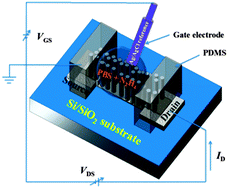Highly sensitive hydrazine chemical sensor based on ZnO nanorods field-effect transistor†
Abstract
A highly sensitive hydrazine chemical sensor has been fabricated based on a field-effect transistor (FET) by growing vertically-aligned ZnO nanorods directly on silver electrodes. The FET sensor showed a high sensitivity and a low limit of detection (LOD) of 59.175 μA cm−2 μM−1 and ∼3.86 nM, respectively. This demonstrates a cost effective and low power consuming FET strategy for the detection of hydrazine.


 Please wait while we load your content...
Please wait while we load your content...